Act of Faith - Brutal vengeance from the men of God
"Daddy, can we go to the burning?"
Attendance at an auto-da-fé (Portuguese for “Act of Faith”) was not merely a major social event and civic occasion: it was a religious act which even the king himself was obliged to attend. It was a collective act of sacrifice in which victims were roasted to appease the Christian godman. The first auto was held in Seville in 1481, the last in Mexico in 1850. Such Church/State terror (a pretence was maintained that the secular authorities carried out the actual murders) not only enforced religious devotion and conformity: it provided substantial income from property confiscated from the victims.
Solemn Procession
Doomed prisoners were led in procession to the place of execution. The burning would be held on a Sunday or other holy day so that the maximum number of people could attend.
A Jesuit priest would walk on either side of each victim, gagged to prevent any words of outrage.The priests would intone the gospels and ‘wrestle for his soul.’
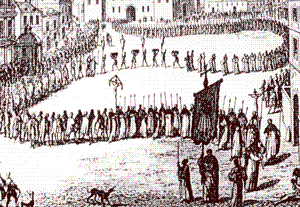
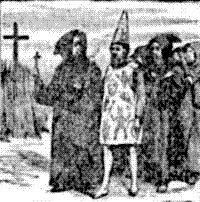
Caricatured Victim
Decked out in a yellow ‘san benito’ penitential garment and wearing a 3′ pointed ‘coroza’ cap – both painted with effigies, the flames of hell and devils, the victims would be given opportunities to recant and suffer a less painful death.
Garroting for last minute repentance
If a victim ‘converted’ to Catholicism at the last minute (“fuego resuelto”) in its loving kindness the Church would sanction strangulation before burning.
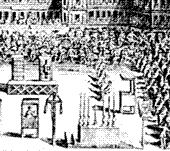
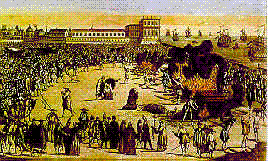
Burning for the unrepentant
Those about to be murdered would first have their faces burned, a bit of fun to excite the crowd.
The corpses of those who had died during torture would also be burnt; those who had fled burnt in effigy.
A Fine Christian Sacrament, Exported to the Colonies too...
Mexico, Brazil and Peru would enjoy the delights of the auto-da-fé long after it lost its charm in Europe. Mexico witnessed its last auto-da-fé as late as 1850.
Did wonders for the conversion of the natives.
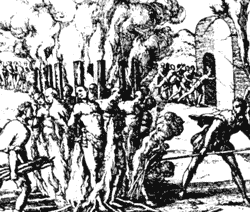
Tariff for Torture, 1757
All the costs of conducting a trial and torture had to be paid by the hapless victim or by his relations. But that was not always possible.
In the German lands, the city of Cologne (originally established as a Roman colonia) had grown into a leading commercial and ecclesiastical centre. The town profitted hugely from a 10th century fabrication of mass martyrdom – Saint Ursula and, variously, 5, 8, 11 and eventually, 11,000 virgin victims! – and a major trade in bones (probably taken from pagan graveyards). Monasteries proliferated and the local prince-bishop rose to become one of the seven electors of the Holy Roman Empire.
Church-sanctioned murder was no stranger to the Rhineland and in the mid-18th century the bishop of Cologne was most concerned that his High Executioner did not profit at his expense by claiming for tortures and murders not performed.
He set out, in “exquisite detail”, the precise payments that would be made for diverse acts of sadism.
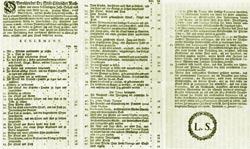
Price list – Cornell University Library
Price list of Christian Butchery – as set down by the Archbishopric of Cologne
Even though the Archbishopric of Cologne has previously endowed the high executioner with a permanent yearly income of 80 reichsthaler, 20 albus, 12 malder of grain, and 4 cords of wood, nevertheless it has turned out that during and after performing executions and other matters connected with them, so many unsubstantiated and exaggeated claims for extra expenses have been made that it has become very costly for the chief court of the Elector Archbishop.
Therefore, the Archbishopric is compelled, in order to contain these demands, to set up the following rules in which every single operation has been given its due charge, which is forthwith promulgated.”
Bonn, January 15, 1757.
"Three Kings from the East".
To dazzle the credulous the sacred precincts of Cologne Cathedral house a gold sarcophagus said to contain the bones of the Magi or Three Kings. These bones are also to be found in Milan – sacred relics have that miraculous ability to be in more than one place at the same time.
For centuries the city of Cologne was famous for the opulence of its churches and the remarkable army of beggars that frequented them.
If walls could talk…
Cologne Cathedral took seven centuries to complete. The Coliseum in Rome took 8 years.

Highlights from the Christian Menu of Death
1. For tearing apart and quartering by four horses … 5 Thaler, 26 Albus
4. For hanging the four quarters in four corners, the necessary rope, nails, chains, and the transport included … 5,26
5. For beheading and burning, everything included … 5,26
9. For burning alive … 4,0
11. For breaking alive on the wheel … 4,0
17. For beheading and tying the body on the wheel … 4,0
19. For cutting off a hand or several fingers and for beheading, all together … 3, 26
20. The same: in addition, for burning with a hot iron … 1,26
24. For beheading and tying the body on the wheel and for sticking the head on a pole, all together … 5,0
28. Before the actual execution starts, for squeezing the delinquent with red-hot tongs, apart from the above-mentioned fee for hanging, for every application … 0,26
29. For cutting out the tongue entirely, or part of it, and afterwards for burning the mouth with a red-hot iron … 5,0
31. For nailing to the gallows a cut-off tongue or a chopped-off hand … 1,26
38. For putting in the pillory, branding, and whipping, including coals, rope, and rods, also the branding ointment … 2,0
41. For terrorizing by showing the instruments of torture …1,0
Sources
- Dan Cohn-Sherbok, The Crucified Jew (Harper Collins,1992)
- Helen Ellerbe, The Dark Side of Christian History (Morningstar & Lark, 1995)
- Leslie Houlden (Ed.), Judaism & Christianity (Routledge, 1988)
- Norman Cantor, The Sacred Chain – A History of the Jews (Harper Collins, 1994)
- George Scott, A History of Torture (Senate, 1995)
- Alice K. Turner, The History of Hell (Robert Hale, 1995)
Related articles
Missionaries or Murderers? – The Christianising of Europe
The Papal Princes – Christian Lords of Hell on Earth
The Church Fathers – Putting the Dark into the Dark Age…
1000 Years of Carnage & Barbarity in the name of Christ
Burning Times – Auto da fe
Not what the Bible had in mind? A corruption of 'the Word'?
From the Godman
Himself …
“The Son of man shall send forth his angels, and they shall gather out of his kingdom all things that offend, and them which do iniquity;
And shall cast them into a furnace of fire: there shall be wailing and gnashing of teeth.
Then shall the righteous shine forth as the sun in the kingdom of their Father.”
– Matthew 13.41,43.
Matthew’s ‘gentle Jesus’ sanctions the burning of heretics, Jews, witches and unbelievers.
Sanitized Christianity now prefers to quote the anodyne verse that follows from above:
“Who hath ears to hear, let him hear.
From the Godman Himself ...
“If a man abide not in me, he is cast forth as a branch, and is withered; and men gather them, and cast them into the fire, and they are burned.”
– John 15.6.
From John the Baptist...
“Every tree therefore which bringeth not forth good fruit is hewn down, and cast into the fire.”
– Luke 3.12.
Tariff for Torture
1. For tearing apart and quartering by four horses 5 / 26
2. For quartering 4 / 0
3. For the necessary rope for that purpose 1 / 0
4. For hanging the four quarters in four corners, the necessary rope, nails, chains, and the transport included 5 / 26
5. For beheading and burning, everything included 5 / 26 6. For the necessary rope for this procedure, and for preparing and igniting the stake 2 / 0
7. For strangling and burning 4 / 0
8. For rope and for preparing and igniting the stake 2 / 0
9. For burning alive 4 / 0
10. For rope and for preparing and igniting the stake 2 / 0
11. For breaking alive on the wheel 4 / 0
12. For rope and chains for this procedure 2 / 0
13. For setting up the body which is tied to the wheel 2 / 52
14. For beheading only 2 / 52
15. For the necessary rope for this purpose and for cloth to cover the face 1 / 0
16. For making a hole and disposing of the corpse 1 / 26
17. For beheading and tying the body on the wheel 4 / 0
18. For the necessary rope and chains, together with the cloth 2
19. For cutting off a hand or several fingers and for beheading, all together 3 / 26
20. The same: in addition, for burning with a hot iron 1 / 26
21. For the necessary rope and cloth 1 / 26
22. For beheading and sticking the head on a pole 3 / 26
23. For the necessary rope and cloth 1 / 26
24. For beheading and tying the body on the wheel and for sticking the head on a pole, all together 5 / 0
25. For the necessary rope, chains, and cloth 2 / 0
26. For hanging 2 / 52
27. For the necessary rope, nails, and chain needed for that purpose 1 / 26
28. Before the actual execution starts, for squeezing the delinquent with red-hot tongs, apart from the above-mentioned fee for hanging, for every application 0 / 26
29. For cutting out the tongue entirely, or part of it, and afterwards for burning the mouth with a red-hot iron 5 / 0
30. For this procedure, the usual rope, tongs, and knife 2 / 0
31. For nailing to the gallows a cut-off tongue or a chopped-off hand 1 / 26
32. For one who has hanged himself, or drowned himself, or otherwise taken his own life: to take down, remove, and dig a hole to dispose of the corpse 2/0
33. For exiling a person from the city or country 0 / 52
34. For flogging in jail, including the rods 1 / 0
35. For thrashing 0 / 52
36. For putting in the pillory 0 / 52
37. For putting in the pillory, and for whipping, including the rope and the rods 1 / 26
38. For putting in the pillory, branding, and whipping, including coals, rope, and rods, also the branding ointment 2 / 0
39. For inspecting a prisoner after he has been branded 0 / 20
40. For putting the ladder to the gallows, regardless whether one or several are hanged on the same day 2 / 0
2. For quartering 4 / 0
3. For the necessary rope for that purpose 1 / 0
4. For hanging the four quarters in four corners, the necessary rope, nails, chains, and the transport included 5 / 26
5. For beheading and burning, everything included 5 / 26 6. For the necessary rope for this procedure, and for preparing and igniting the stake 2 / 0
7. For strangling and burning 4 / 0
8. For rope and for preparing and igniting the stake 2 / 0
9. For burning alive 4 / 0
10. For rope and for preparing and igniting the stake 2 / 0
11. For breaking alive on the wheel 4 / 0
12. For rope and chains for this procedure 2 / 0
13. For setting up the body which is tied to the wheel 2 / 52
14. For beheading only 2 / 52
15. For the necessary rope for this purpose and for cloth to cover the face 1 / 0
16. For making a hole and disposing of the corpse 1 / 26
17. For beheading and tying the body on the wheel 4 / 0
18. For the necessary rope and chains, together with the cloth 2
19. For cutting off a hand or several fingers and for beheading, all together 3 / 26
20. The same: in addition, for burning with a hot iron 1 / 26
21. For the necessary rope and cloth 1 / 26
22. For beheading and sticking the head on a pole 3 / 26
23. For the necessary rope and cloth 1 / 26
24. For beheading and tying the body on the wheel and for sticking the head on a pole, all together 5 / 0
25. For the necessary rope, chains, and cloth 2 / 0
26. For hanging 2 / 52
27. For the necessary rope, nails, and chain needed for that purpose 1 / 26
28. Before the actual execution starts, for squeezing the delinquent with red-hot tongs, apart from the above-mentioned fee for hanging, for every application 0 / 26
29. For cutting out the tongue entirely, or part of it, and afterwards for burning the mouth with a red-hot iron 5 / 0
30. For this procedure, the usual rope, tongs, and knife 2 / 0
31. For nailing to the gallows a cut-off tongue or a chopped-off hand 1 / 26
32. For one who has hanged himself, or drowned himself, or otherwise taken his own life: to take down, remove, and dig a hole to dispose of the corpse 2/0
33. For exiling a person from the city or country 0 / 52
34. For flogging in jail, including the rods 1 / 0
35. For thrashing 0 / 52
36. For putting in the pillory 0 / 52
37. For putting in the pillory, and for whipping, including the rope and the rods 1 / 26
38. For putting in the pillory, branding, and whipping, including coals, rope, and rods, also the branding ointment 2 / 0
39. For inspecting a prisoner after he has been branded 0 / 20
40. For putting the ladder to the gallows, regardless whether one or several are hanged on the same day 2 / 0
Concerning Torture
41. For terrorizing by showing the instruments of torture 1 / 0
42. For the first degree of torture 1 / 26 43. For arranging and crushing the thumb for this degree 0 / 26 44. For the second degree of torture, including setting the limbs afterward, and for salve which is used 2 / 26
45. Should, however, a person be tortured in both degrees of torture, the executioner is to get for both degrees performed at the same time, setting the limbs afterward and for use of the salve, for all this he should be paid 6 / 0
46. For travel and daily expenses for every day, exclusive, however, of the days of execution or torture, regardless whether on these days one or several criminals are punished 0 / 48
47. For daily food 1 / 26
48. For each help 0 / 39
49. For hiring a horse, together with fodder and stabling, the daily fee 1 / 16
50. If a torture or execution takes place in Cologne, the executioner shall receive for this procedure the aforementioned execution fees, without any addition of other extra expenses, such as travel, daily expenses, food, horse hay and fodder; and he has to be satisfied with the above-mentioned execution fee.
51. When he performs executions in Melaten and Deutz, he receives extra expenses for hay for his horse, and nothing else.
52. Since items 16, 32, and 40 of the present rules fall within the province of the weapons master, therefore the weapons master should receive the respective fees.
53. Should the executioner perform functions for those who are vassals or sub-vassals of the archbishopric, he should receive one third more than before specified, the reason being that he enjoys his yearly investiture without any emolument from the aforesaid vassals.
54. Only the executioner and no stranger shall be employed by the vassals or sub-vassals for whatever executions have to be done.
55. Because there have been many complaints that at an execution where an official of the archbishopric presides, the executioner, either in addition to accepting the fees, or instead of accepting them, dared to demand a certain sum of money, and since this demand is regarded as an abuse, it is once and for all forbidden.
42. For the first degree of torture 1 / 26 43. For arranging and crushing the thumb for this degree 0 / 26 44. For the second degree of torture, including setting the limbs afterward, and for salve which is used 2 / 26
45. Should, however, a person be tortured in both degrees of torture, the executioner is to get for both degrees performed at the same time, setting the limbs afterward and for use of the salve, for all this he should be paid 6 / 0
46. For travel and daily expenses for every day, exclusive, however, of the days of execution or torture, regardless whether on these days one or several criminals are punished 0 / 48
47. For daily food 1 / 26
48. For each help 0 / 39
49. For hiring a horse, together with fodder and stabling, the daily fee 1 / 16
50. If a torture or execution takes place in Cologne, the executioner shall receive for this procedure the aforementioned execution fees, without any addition of other extra expenses, such as travel, daily expenses, food, horse hay and fodder; and he has to be satisfied with the above-mentioned execution fee.
51. When he performs executions in Melaten and Deutz, he receives extra expenses for hay for his horse, and nothing else.
52. Since items 16, 32, and 40 of the present rules fall within the province of the weapons master, therefore the weapons master should receive the respective fees.
53. Should the executioner perform functions for those who are vassals or sub-vassals of the archbishopric, he should receive one third more than before specified, the reason being that he enjoys his yearly investiture without any emolument from the aforesaid vassals.
54. Only the executioner and no stranger shall be employed by the vassals or sub-vassals for whatever executions have to be done.
55. Because there have been many complaints that at an execution where an official of the archbishopric presides, the executioner, either in addition to accepting the fees, or instead of accepting them, dared to demand a certain sum of money, and since this demand is regarded as an abuse, it is once and for all forbidden.
Therefore, herewith we order that
every official of the archbishopric keep strictly to the above-mentioned rules and pay the executioners only the stipulated fees and nothing else, any time there is an execution; and they are asked to submit afterward their accounts with all their vouchers to the treasury of the archbishop.
Given at Bonn, January 15, 1757.
